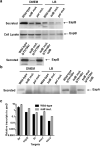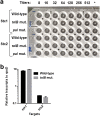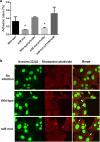Roles of the Tol-Pal system in the Type III secretion system and flagella-mediated virulence in enterohemorrhagic Escherichia coli
- PMID: 32968151
- PMCID: PMC7511404
- DOI: 10.1038/s41598-020-72412-w
Roles of the Tol-Pal system in the Type III secretion system and flagella-mediated virulence in enterohemorrhagic Escherichia coli
Abstract
The Tol-Pal system is a protein complex that is highly conserved in many gram-negative bacteria. We show here that the Tol-Pal system is associated with the enteric pathogenesis of enterohemorrhagic E. coli (EHEC). Deletion of tolB, which is required for the Tol-Pal system decreased motility, secretion of the Type III secretion system proteins EspA/B, and the ability of bacteria to adhere to and to form attaching and effacing (A/E) lesions in host cells, but the expression level of LEE genes, including espA/B that encode Type III secretion system proteins were not affected. The Citrobacter rodentium, tolB mutant, that is traditionally used to estimate Type III secretion system associated virulence in mice did not cause lethality in mice while it induced anti-bacterial immunity. We also found that the pal mutant, which lacks activity of the Tol-Pal system, exhibited lower motility and EspA/B secretion than the wild-type parent. These combined results indicate that the Tol-Pal system contributes to the virulence of EHEC associated with the Type III secretion system and flagellar activity for infection at enteric sites. This finding provides evidence that the Tol-Pal system may be an effective target for the treatment of infectious diseases caused by pathogenic E. coli.
Conflict of interest statement
The authors declare no competing interests.
Figures







Similar articles
-
The Surface Sensor NlpE of Enterohemorrhagic Escherichia coli Contributes to Regulation of the Type III Secretion System and Flagella by the Cpx Response to Adhesion.Infect Immun. 2015 Dec 7;84(2):537-49. doi: 10.1128/IAI.00881-15. Print 2016 Feb. Infect Immun. 2015. PMID: 26644384 Free PMC article.
-
Bacteriophage Transcription Factor Cro Regulates Virulence Gene Expression in Enterohemorrhagic Escherichia coli.Cell Host Microbe. 2018 May 9;23(5):607-617.e6. doi: 10.1016/j.chom.2018.04.007. Cell Host Microbe. 2018. PMID: 29746832 Free PMC article.
-
The QseG Lipoprotein Impacts the Virulence of Enterohemorrhagic Escherichia coli and Citrobacter rodentium and Regulates Flagellar Phase Variation in Salmonella enterica Serovar Typhimurium.Infect Immun. 2018 Mar 22;86(4):e00936-17. doi: 10.1128/IAI.00936-17. Print 2018 Apr. Infect Immun. 2018. PMID: 29358334 Free PMC article.
-
Type Three Secretion System in Attaching and Effacing Pathogens.Front Cell Infect Microbiol. 2016 Oct 21;6:129. doi: 10.3389/fcimb.2016.00129. eCollection 2016. Front Cell Infect Microbiol. 2016. PMID: 27818950 Free PMC article. Review.
-
Escherichia coli type III secretion system 2: a new kind of T3SS?Vet Res. 2014 Mar 19;45(1):32. doi: 10.1186/1297-9716-45-32. Vet Res. 2014. PMID: 24641581 Free PMC article. Review.
Cited by
-
Attenuated mutants of Salmonella enterica Typhimurium mediate melanoma regression via an immune response.Exp Biol Med (Maywood). 2024 Jun 21;249:10081. doi: 10.3389/ebm.2024.10081. eCollection 2024. Exp Biol Med (Maywood). 2024. PMID: 38974834 Free PMC article.
-
The Tol-Pal system of Acinetobacter baumannii is important for cell morphology, antibiotic resistance and virulence.Int Microbiol. 2023 Aug;26(3):543-550. doi: 10.1007/s10123-022-00319-9. Epub 2023 Jan 17. Int Microbiol. 2023. PMID: 36648597 Free PMC article.
-
Roles of the Tol/Pal System in Bacterial Pathogenesis and Its Application to Antibacterial Therapy.Vaccines (Basel). 2022 Mar 10;10(3):422. doi: 10.3390/vaccines10030422. Vaccines (Basel). 2022. PMID: 35335056 Free PMC article. Review.
-
Plant Signals Anticipate the Induction of the Type III Secretion System in Pseudomonas syringae pv. actinidiae, Facilitating Efficient Temperature-Dependent Effector Translocation.Microbiol Spectr. 2022 Dec 21;10(6):e0207322. doi: 10.1128/spectrum.02073-22. Epub 2022 Oct 26. Microbiol Spectr. 2022. PMID: 36287008 Free PMC article.
-
A Macroporous Magnesium Oxide-Templated Carbon Adsorbs Shiga Toxins and Type III Secretory Proteins in Enterohemorrhagic Escherichia coli, Which Attenuates Virulence.Front Microbiol. 2022 May 6;13:883689. doi: 10.3389/fmicb.2022.883689. eCollection 2022. Front Microbiol. 2022. PMID: 35602086 Free PMC article.
References
-
- Tarr PI, Gordon CA, Chandler WL. Shiga-toxin-producing Escherichia coli and haemolytic uraemic syndrome. Lancet. 2005;365:1073–1086. - PubMed
Publication types
MeSH terms
Substances
LinkOut - more resources
Full Text Sources

